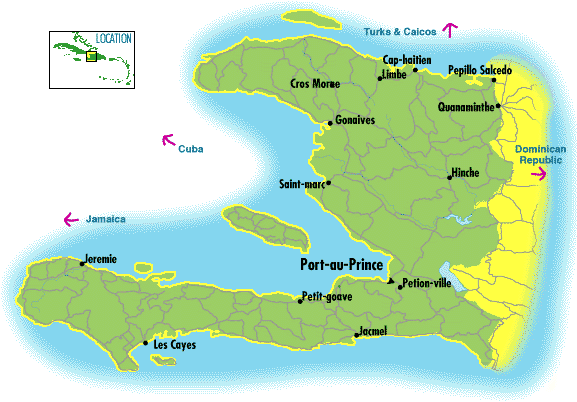
Haiti '99

Thu 4 Feb. morning depart London
... and arrive in Miami in the afternoon. We will overnight in Miami - Anna says the airport in Port-au-Prince will be more manageable in the morning. This is good advice and we are glad of the opportunity for a first look at Miami and a dinner at Bayside Park - many shops and cafés in a harbour-side setting. We're somewhat startled to find that Spanish is the first language of most shopkeepers and many of the visitors in Miami. Eat Cuban food and pass a restful night at the Airport Quality Inn, 2373 Lejeune Rd, Miami.
Fri 5 Feb.
We join a throng of Haitians at the 8.25 Miami check-in. Arrive Port-au-Prince 10.22. Itís less than two hours flight from Miami to Haiti, but the two could hardly be more different. It was our first visit to a black country and we are a little surprised by the sea of black faces. We get through the airport quite quickly and easily spot Anna waiting outside the fence. (Non-passengers aren't allowed in. This was our first taste of the enclaved character of a lot of many places in Port-au-Prince (most hotels, supermarkets, even art galleries have armed guards at the entrance). Anna manages to bring her Nissan Patrol in and we are driven to the Hertz office by Stanley (the Haitian UN driver from Hinche). Hertz here is small - maybe five or six cars. They take their time doing the booking, but chat to you and make you sign a form accepting $2000 excess for theft or damage due to riot or civil unrest. Anna drove our Suzuki Samurai through Port-au-Prince to Pétionville, using Avenue Delmas - she managed to cope with the many potholes and the unexpected behaviour of the other drivers with quite a lot of aggression and some angry remarks in French.
The Villa Créole hotel is in an enclave with a guarded entrance in the suburb of Pétionville, up the hill from the capital and a little cooler. The Villa Créole is a comfortable hotel with a pleasant pool surrounded by a terrace with seats and tables under the trees. Breakfast and drinks are served on the terrace.
We swam, had lunch and a siesta. They serve very nice fruit juice cocktails with or without rum. When we came out again, we met Gill and another of Annaís UN colleagues (John from NZ).
In the afternoon Anna took us to see two galleries in Pétionville. 
The first (Gallerie Marasa?) had a collection of mostly modern Haitian painters, some fer forgé, and an assortment of wooden articles decorated with colourful parrots and bright green leaves. The second: Gallerie Monnin above the Café des Arts was run by an American woman who gave us a run down of Haitian painting and showed us many nice primitive paintings. George spotted the work of Louisianne St. Fleurant who uses a modern-primitive approach to paint simple figures.
After two galleries, Anna started to feel rather unwell. We went back to the Villa Créole and she retired to bed with a temperature. We were rather worried it might be malaria, but as it turned out she recovered completely the next morning. After supper we met helicopter man Mike who had come to see how Anna was faring.
Sat 6 Feb
Good breakfast - they offer fruit juices and fruit (mangoes, melon, bananas). We also had croissants or American style pancakes. They offer ëcontinentaleí style breakfast.
Drove with Anna up the mountain to Kenscoff, passing some smart mansions and stopping at the Baptist mission to shop and have lunch. We bought a pair of appliquéd hessian pictures and a tray hollowed out from a solid piece of wood.
In the evening we went to the French Institute to see some of Haiti's leading performing artists; the modern dance troupe Artcho Danse in a homage to their founder and director Renel Delsoin (Azibé). We travelled to the Institute's downtown location in Gillís car via Rue Panamericaine, waiting a long time at the darkened and traffic-jammed junction with Martin Luther King - traffic lights frequently donít function in PaP because the electricity supply is switched off. Two other ex-Amnesty UN women - Victoria and Sandra came too. Victoria works at Gonaive and told us about her visit to Cap Haitien.
The French Institute contains an open ended auditorium which was packed. The company are one of Haiti's showpieces. We were extremely impressed by their expressive and athletic dancing. There were also outstanding recitals and performances by other Haitian musicians and actors; we couldnít understand some of the jokes in Créole but the well-dressed Haitian audience enjoyed it immensely; the warm relationship between audience and performers spoke of a deeply appreciated musical and verbal culture. An impressive event.
Sun 7 Feb
Breakfast with Anna and Gill. 
Went to a small but very well-stocked supermarket (guarded as usual by a man with a gun) where Anna bought her weekly supplies and we got some food and water for our forthcoming journey to Jacmel.
Anna set of for Hinche. We went down to Port-au-Prince to look
at The Oloffson Hotel on which the Hotel Trianon in Graham Greenís
novel The Comedians is based. The Oloffson is in a run-down
residential area near the centre of Port-au-Prince and is surrounded
by lush gardens.  The
front of the well-preserved wooden building is decorated with
fine white painted fretwork. We had lunch on the balcony and heard
a elderly Haitian writer gossiping and gathering material from
a visiting American writer and an English galley owner. He was
clearly a part of the furniture; we were reminded of Petit Pierre
in Greenís novel. Some rooms (nos 1-8) have a fine view
of the city and the bay.
The
front of the well-preserved wooden building is decorated with
fine white painted fretwork. We had lunch on the balcony and heard
a elderly Haitian writer gossiping and gathering material from
a visiting American writer and an English galley owner. He was
clearly a part of the furniture; we were reminded of Petit Pierre
in Greenís novel. Some rooms (nos 1-8) have a fine view
of the city and the bay. 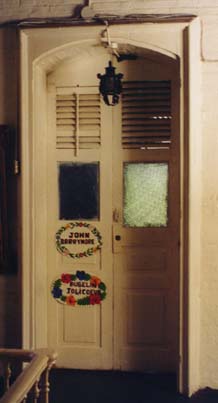 The
John Barrymore Suite which figures in The Comedians is
there in real life.
The
John Barrymore Suite which figures in The Comedians is
there in real life.
In the evening at Villa Créole we heard the sounds of
carnival and decided to go out on the street to investigate. This
was our first sortie on foot beyond the enclave with its armed
guard at the gate. All the roads were full of people playing music,
drinking, dancing and generally enjoying themselves.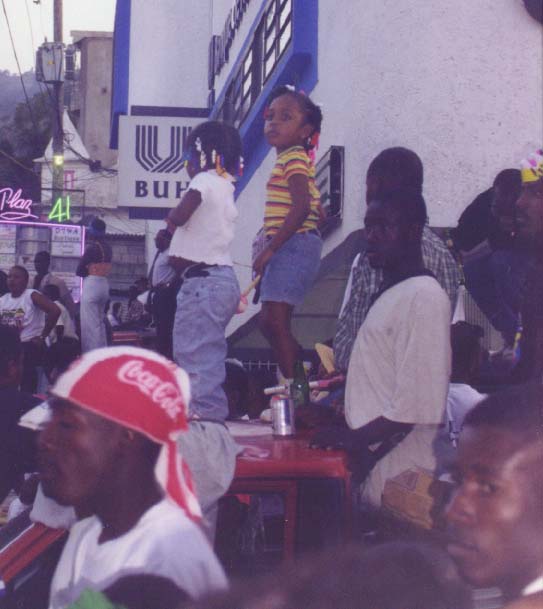 There were no masks, but carnival wasnít due until the
following week. We were a subject of only slight curiosity; an
old man, the subject of one of our photos, demanded a pourboire.
There were no masks, but carnival wasnít due until the
following week. We were a subject of only slight curiosity; an
old man, the subject of one of our photos, demanded a pourboire.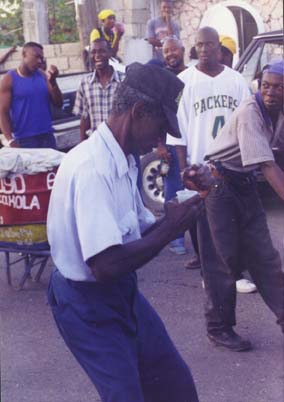
Mon 8 Feb
Set off on our three-to-four hour drive to south coast town of Jacmel, expecting to get lost as there are no signposts on any of the roads in Haiti.
Following Gill's excellent directions we took the ëCanape Vertí route down from Petionville and continued through Port-au-Prince. Amazingly we didnít get lost, but we did run into a sizable flood in Blvd Dessalines. The road along the coast as far as Léogane is badly broken up and full of reconstruction workers, lorries and piles of dirt and gravel, all mingled with the traffic. Driving on it involved finding a viable track that wasn't currently occupied by oncoming traffic and passing it on either side!
All along the way we saw many Tap Taps - pickups or larger
trucks with an added roof and an extension at the back to make
room for extra passengers - a Toyota pickup might accommodate
up to twenty people sitting and standing.  Tap
Taps are painted beautifully and have messages such as ëJesus
come backí and ëChrist Saveurí. The slightly
bigger buses have passengers on the roof and on the ladder at
the back. In the built up parts there are people with small stalls
selling fruit and vegetables or drinks.
Tap
Taps are painted beautifully and have messages such as ëJesus
come backí and ëChrist Saveurí. The slightly
bigger buses have passengers on the roof and on the ladder at
the back. In the built up parts there are people with small stalls
selling fruit and vegetables or drinks.
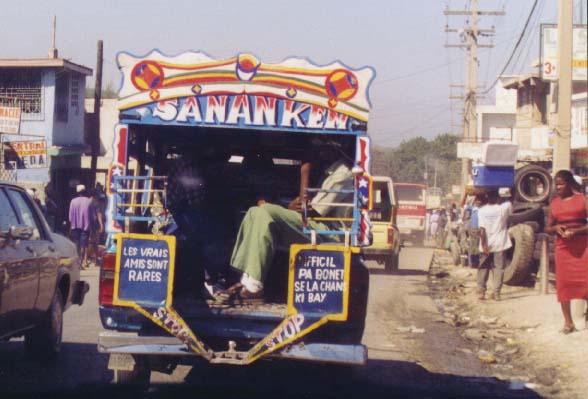
Near Port-au-Prince the roads are lined with shanty towns and
slightly more permanent houses - small one or two room shacks
made of wood or concrete and with corrugated iron roofs usually
with added porches with straw roofs and rough wooden props. Whole
families sit on the porches. 
We spotted the Dufort crossroads where we had to turn off.
The road across the mountains to Jacmel is excellent; apparently
recently-built by a French construction firm, the engineering
noticeably resembles a Route Nationale. We passed through several
villages with slightly larger houses, some pleasantly situated.
The better-built houses have concrete cisterns to hold water collected
from the roof. Descending into Jacmel we skirted a river where
a section of the less than two year old road been completely washed
away in a recent hurricane. The mountainside here is quite bare, 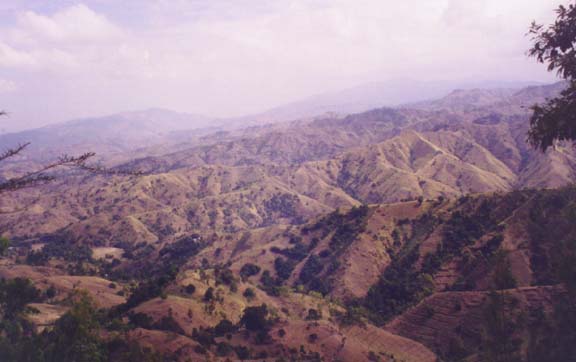 although the road runs some of the way in
a green valley. Here we saw a lot of people walking about, carrying
farming tools and produce; leaving baskets beside the road containing
bananas and beans. There were sellers too, with piles of chadèques
and other fruit and vegetables.
although the road runs some of the way in
a green valley. Here we saw a lot of people walking about, carrying
farming tools and produce; leaving baskets beside the road containing
bananas and beans. There were sellers too, with piles of chadèques
and other fruit and vegetables.
We found our way through Jacmel and onto the 7 km hard-packed
dirt road eastward along the coast to Civadier Plage. The road
is good by Haiti standards, but like most roads, there are washed-out
sections that require careful driving. The Civadier Plage hotel
has several cabins in a large garden and a larger building overlooking
a small bay. It is run by Hans Geffoy - a Swiss who donates some
of the hotel's income to local SOS enfants. Located in rural environment,
it needs no guard. Our deluxe room was excellent, facing
the cove with a balcony and a coconut palm right by it.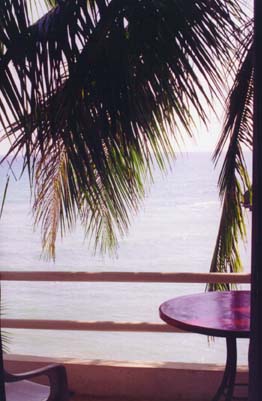 The cove is very beautiful with rocks and palm trees all round.
We swam in the bay both days. George had a conversation with a
local youth who wanted to sell us langoustines or take
us on a boat trip. They somehow managed to communicate although
the boy was speaking Créole.
The cove is very beautiful with rocks and palm trees all round.
We swam in the bay both days. George had a conversation with a
local youth who wanted to sell us langoustines or take
us on a boat trip. They somehow managed to communicate although
the boy was speaking Créole.
We walked a couple of miles along the coast. The scenery is
beautiful with banana trees ,
palms and other crops. The soil seems good in places and we passed
through a lot of tiny peasant smallholdings. We saw people tending
animals and they seemed friendly. The work is labour intensive
as each cow, goat, pig or horse is tethered and has to be moved
regularly to a green patch.
,
palms and other crops. The soil seems good in places and we passed
through a lot of tiny peasant smallholdings. We saw people tending
animals and they seemed friendly. The work is labour intensive
as each cow, goat, pig or horse is tethered and has to be moved
regularly to a green patch. 
Evening meal of langoustines at hotel. Very good. You order the meal in the kitchen by 6 pm and it is brought out to the terrace later on. Meals are included in the very reasonable price (US$50/person/day).
Tue 9 Feb
For breakfast we had chadèque juice with bread and jam. (Chadèques are large, nobbly citrus fruit resembling grapefruit but with a distinctive taste).
We went to see Jacmel town in the morning. Spotting the UN/MICIVIH
office on the road into town, we went in to meet Kamran Khosrowshahi,
the MICIVIH staffer who had booked us into the Civadier Plage
hotel at Anna's request. Kamran had certainly done us proud with
one of the best rooms! He was charming to us, showing us the videos
of the 1998 and 99 Jacmel carnivals, which he happened to be editing.
Jacmel has one of the most colourful and musical carnivals in
Haiti, with floats, giant papier maché figures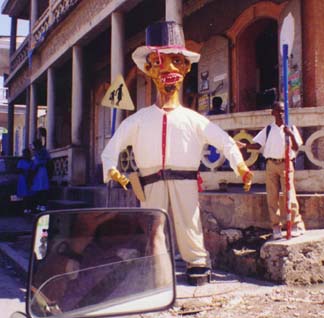 , etc. We were just a week too late to see it!
Kamran told us about the highlights of Jacmel and gave us a hand-drawn
map.
, etc. We were just a week too late to see it!
Kamran told us about the highlights of Jacmel and gave us a hand-drawn
map.
An old rusty ship is stranded on the town beach, having been
driven up in a hurricane. The beach is picturesque with palm trees
but untidy and fairly littered. 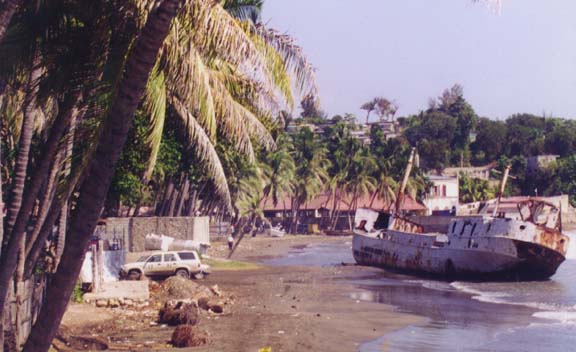
There is a small port with a few ships. These signs illustrate
the simple corresponce between Creole and other languages. 
The town has many nice French colonial style wooden houses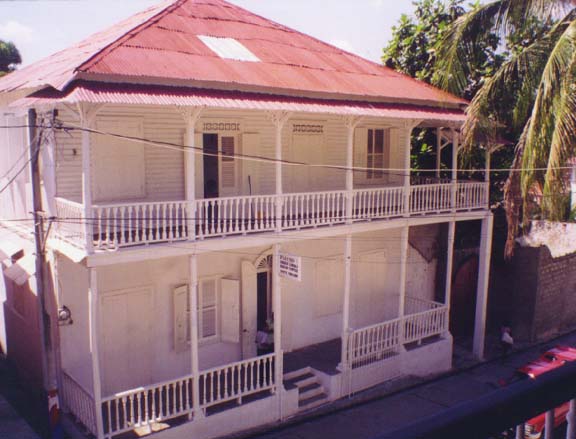 , some with grand balconies
supported by cast iron columns. The street along the coast is
called Baranquilla - the name of a town in Venezuela which is
due south.
, some with grand balconies
supported by cast iron columns. The street along the coast is
called Baranquilla - the name of a town in Venezuela which is
due south.
Visited the Bricston Gallery in Jacmel. A lovely blue and white
colonial style house owned by an American who spends half the
year in Jacmel and the other half in San Diego. 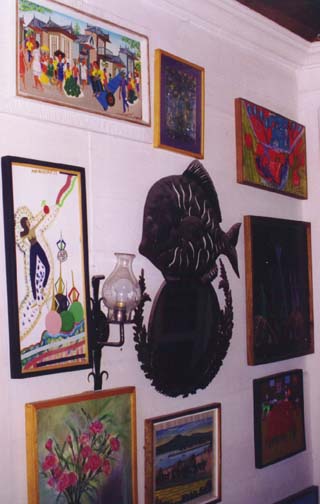 He has a fine collection of Haitian primitive paintings
including Louisianne St. Fleurant whose work we like, but found
too expensive. We bought a Casimir for ourselves, a Joel Balon
for Sue and Renzo and a piece of fer forgé for Jasonís
birthday present.
He has a fine collection of Haitian primitive paintings
including Louisianne St. Fleurant whose work we like, but found
too expensive. We bought a Casimir for ourselves, a Joel Balon
for Sue and Renzo and a piece of fer forgé for Jasonís
birthday present.
Back to Civadier Plage for lunch. In the afternoon we went
a few miles further along the coast road.  The dirt surface becomes increasingly corrugated
and the villages seem quite remote and their residents unfamilar
with visitors. When we stopped,
The dirt surface becomes increasingly corrugated
and the villages seem quite remote and their residents unfamilar
with visitors. When we stopped, 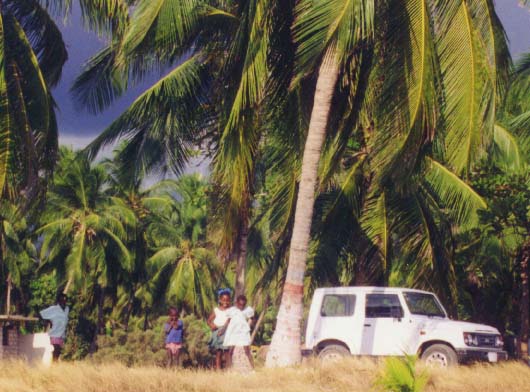 children came up and shouted ëblancs, blancs,
blancsí so we felt too conspicuous to have a swim there.
Even here, the brightly-uniformed young children made a good picture
on there way to school. Whatever their circumstances and wherever
the school may be, most parents seem to make sure that their children
get at least a primary education and provide them with a smart
uniform.
children came up and shouted ëblancs, blancs,
blancsí so we felt too conspicuous to have a swim there.
Even here, the brightly-uniformed young children made a good picture
on there way to school. Whatever their circumstances and wherever
the school may be, most parents seem to make sure that their children
get at least a primary education and provide them with a smart
uniform.


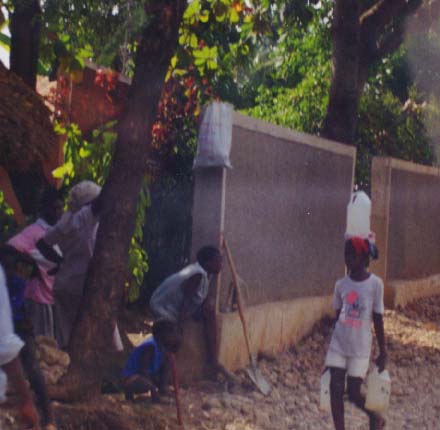
After supper at Civadier Plage, we made good friends with Father Gregory Williams, a Russian Orthodox priest from Tennessee. He was on his first visit to Haiti, spending most of the time with a poor but energetic and constructive group of Orthodox Haitians in Port-au-Prince. His views and insights on the situation of ordinary Haitians and the practical problems the country faces added much to our limited experience.
Wed 10 Feb
We spent the morning on the beach with Father Gregory and then set off after lunch for Port-au-Prince.
We bought petrol in Jacmel, where some locals tried to persuade us to pay them as guides to visit the Bassin Bleu. We took the road across the mountain quite slowly so as to be able to observe the life in the many villages along the way. On the coast road we noticed that there are many rum distilleries, although we couldn't identify the renowned Barbancourt.
Arriving in Port-au-Prince around 5, the traffic in the centre seemed chaotic and last part of the journey took a long time due to queues and police diversions. We got lost, so followed a Belgian diplomatic car as we guessed the driver might be going to Petionville and should know the way better than us. We took Canape Vert again and arrived quite late. We heard later that there had been a major hold up with hostages taken at a bank near the UN/MICIVIH HQ on Delmas.
We spent our last night at Villa Créole. Anna phoned to tell us that there is an American Airlines pilots' strike and many to Miami flights were cancelled.
Thu 11 Feb.
In the morning we were finally able to contact American Airlines and were told that our plane had not been cancelled. We had trouble getting away from the hotel on time and then we couldnít get on to Delmas to leave Pétionville as a street market was blocking the way. We turned around and went down Panamericaine and managed to cross over to Delmas, taking the turning by UN/MICIVIH and finding the Hertz office near the airport to give back the car. Haitian car rental rates are quite high, but surprisingly the pleasant Haitian clerks offered to charge us less than they had originally quoted.
Quickly bussed to the airport by Hertz, we joined a long but disciplined queue of Haitians to check our bags, but then got worried we might be bumped off the plane as earlier and later ones had been cancelled. We decided to take the rapid check-in carrying on all our bags and the works of art which were wrapped only in flimsy paper or towels.
Here ends the story of our first stay in Haiti. We hope to go again. Given the dire economic and social problems and the awful political and human rights history most of the people remain amazingly positive. There is an undercurrent of crime by a minority, but no evidence of hostility towards foreigners. Most expatriates told us their experiences were positive and after a couple of days we too felt quite comfortable in the streets.
MICIVIH - International Civilian Mission in Haiti, OAS/UN
Bonjour Blanc: a Journey Through Haiti, by Ian Thomson
One of the best travel books we have read about anywhere! We wish we had discovered it before going to Haiti.
Caribbean
Islands Handbook 1999, 10th edition, Sarah Cameron, Footprint
Handbooks
Has a very useful 35-page section on Haiti. This is the only relevant
guide we could find, but there are rumours of others in the works,
including a forthcoming Lonely Planet Guide.
Haiti Island Information. Caribbean Vacation Planner!
George Coulouris
Jean Dollimore
March 1999